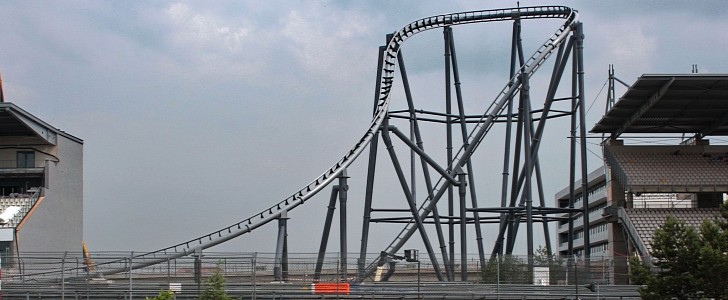One of the most thrilling ways for your average human to feel the power and speed of supercars and other peak automotive machines - without being an F1 driver – is to ride a roller coaster. Well, the folks that manage and operate the Nürburgring know this, and they have a roller coaster that shadows the park.
However, if you ever make it out to the German racing and testing track, all you will ever be able to do with the Ring Racer, the roller coaster we’ll be talking about today, is simply look at it and dream what a ride would be like; maybe watch the video below. That’s because this coaster has never been ridden by the public, and actually, during testing, this bugger basically blew up, injuring a handful of folks working on the ride and even damaging some windows in the vicinity; this one’s no joke.
As you would expect, the Ring Racer was meant to be one of the fastest machines on the planet, capable of propelling its would-be thrill seekers up to a speed of 217 kph (135 mph) in no more than 2.5 seconds. Just to put things into perspective, the Formula Rossa is currently the fastest coaster in the world and can only launch its riders up to a speed of 240 kph (150 mph) in 4.9 seconds.
Like most other roller coasters on this blue marble, the Ring Racer was built to achieve a thrill like few around, and once everything was nice and planned out, construction began on this hunk of steel; it was positioned to run parallel to the track and visitor bleachers. All is nice and proper so far, and even construction went rather smoothly.
The real problems began once this coaster was fired up and tested. On a faithful day of September 3rd, 2009, engineers decided that it was time to finally unleash everything the Ring Racer had in store in the designs: until that point, it had been operating at reduced power levels to ensure everything was good to go.
It was then and there that the launch system gave out, causing multiple explosions and injuring those faithful engineers, even damaging nearby buildings by blowing out their windows. That was a pretty powerful blast if you ask me. Just as the dream became a reality, it soon became a nightmare, and things stayed that way for a few years.
As time passed, investors seemed to want to see returns on their €12.3 million flop, so fixing the busted contraption was underway. Finally, on Halloween (October 31st), 2013, the Ring Racer was reopened for riding. Now, here’s where things get a tad grey; the Ring Racer only functioned from 2:00 p.m. to 5:30 p.m., and if the lines are anything like they are today, you may have missed the chance to ride this bugger. Furthermore, it was only open three days before closing on November 3rd of that same year because operations costs weren’t aligned with projections. We can say that rollercoasters are not what German engineering is known for.
I tried to find out how many people, if any, had the opportunity to ride this bugger and found no numbers anywhere. There is footage of this coaster operating with people in it, yet I’m unsure of the context of those humans in this rather questionable ride.
These days, you can still take a photo of the Ring Racer, but as nothing more than a contraption catching dust and rusting from humidity, rain, and snow. I wonder if the management still pumps cash into keeping this thing looking fresh. After all, if you visit the Nürburgring, the last thing you want to see is a looming hunk of rusting steel with a rather nightmarish history. Happy Halloween!
As you would expect, the Ring Racer was meant to be one of the fastest machines on the planet, capable of propelling its would-be thrill seekers up to a speed of 217 kph (135 mph) in no more than 2.5 seconds. Just to put things into perspective, the Formula Rossa is currently the fastest coaster in the world and can only launch its riders up to a speed of 240 kph (150 mph) in 4.9 seconds.
Like most other roller coasters on this blue marble, the Ring Racer was built to achieve a thrill like few around, and once everything was nice and planned out, construction began on this hunk of steel; it was positioned to run parallel to the track and visitor bleachers. All is nice and proper so far, and even construction went rather smoothly.
It was then and there that the launch system gave out, causing multiple explosions and injuring those faithful engineers, even damaging nearby buildings by blowing out their windows. That was a pretty powerful blast if you ask me. Just as the dream became a reality, it soon became a nightmare, and things stayed that way for a few years.
As time passed, investors seemed to want to see returns on their €12.3 million flop, so fixing the busted contraption was underway. Finally, on Halloween (October 31st), 2013, the Ring Racer was reopened for riding. Now, here’s where things get a tad grey; the Ring Racer only functioned from 2:00 p.m. to 5:30 p.m., and if the lines are anything like they are today, you may have missed the chance to ride this bugger. Furthermore, it was only open three days before closing on November 3rd of that same year because operations costs weren’t aligned with projections. We can say that rollercoasters are not what German engineering is known for.
These days, you can still take a photo of the Ring Racer, but as nothing more than a contraption catching dust and rusting from humidity, rain, and snow. I wonder if the management still pumps cash into keeping this thing looking fresh. After all, if you visit the Nürburgring, the last thing you want to see is a looming hunk of rusting steel with a rather nightmarish history. Happy Halloween!










